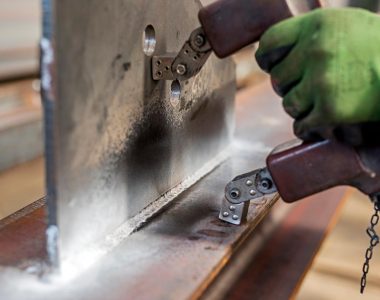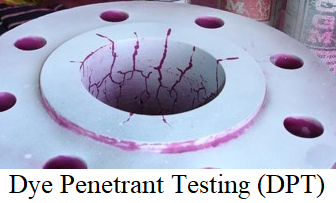
BDNDT Provide Dye Penetrant Test (DPT, LPI, PT) Test service in Bangladesh. Dye Penetrant Testing (DPT) also known as Liquid Penetrant Testing (LPT), is a non-destructive testing (NDT) method used to detect surface-breaking defects in various materials by applying a liquid dye that seeps into cracks and then using a developer to make the dye visible for all.
STEPS TO BE FOLLOWED FOR DYE PENETRANT TEST:
Procedure for Dye Penetrant Test can vary depending upon the factors such as the penetrant system being used and the condition and environment under which the inspection is performed. However, the general steps which are to be followed are as below;
- Surface Preparation: The surface must be thoroughly cleaned, to make it free from dirt, oil, paint, grease, water, or other contaminants. For cleaning one can use dry cloths, solvents, cleaner, rust remover, etc. depending on the condition of the surface to be inspected.
- Penetrant Application: After a thorough cleaning, Penetrant is applied. Penetrant is a red-colored Liquid. It can be applied on the surface by spraying (most common) or by brushing or by immersing the entire surface in a penetrant bath. The temperature of the surface shall be between 5OC to 52OC.
- Dwell period: Leave the penetrant, as it is, on the surface for a minimum period of time (Known as Dwell Time or Dwell Period). During the dwell period, the penetrant seeps into the flaws (if present on the surface being inspected), due to Capillary action. The dwell period varies from 5 minutes to 60 minutes or even more than that depending upon the material and its service condition. The penetrant manufacturer also mentions the dwell period on the product itself. However, there is no harm in going beyond the minimum dwell period, provided that the temperature shall be ambient because at elevated temperature chances of penetrant getting evaporated will be always there. Hence at elevated temperature, one should strictly restrict to the recommended dwell time.
- Removal of excess penetrant: After leaving the surface for the recommended dwell period, the penetrant shall be cleaned, for cleaning the excess penetrant cloth and penetrant removal shall be used. While cleaning the excess penetrant, two things shall be taken care of;
- Cleaning should be unidirectional i.e. cleaning shall be done in one direction only. To and fro cleaning shall be avoided.
- Penetrant remover/cleaner shall not be applied directly on the surface rather apply the penetrant remover/cleaner on the cloth and that cloth should be used for cleaning.
(Method of cleaning may vary, depending on the type of penetrant used)
- Application of Developer: After a thorough cleaning, a thin layer of developer is applied. Two things shall be taken care of while spraying the developer;
- Shake the bottle rigorously
- Maintain a distance of 10 to 12 inches from the surface, while spraying the developer
- After spraying the developer wait for 10 minutes to 60 minutes (development time)
The developer sucks the trapped penetrant on the surface, from the flaws (if present). That is the penetrant bleeds out on the surface and it appears in sharp red color. The developer is a white color liquid and hence the penetrant appears in a sharp red color, hence we can easily identify the flaws.
- Inspection: After the application of the developer wait for 10 to 60 minutes and then perform the inspection. Appropriate lighting is necessary to detect the indications from any flaws which may be present. The minimum light required is 1000 Lux or 100 foot-candles.


